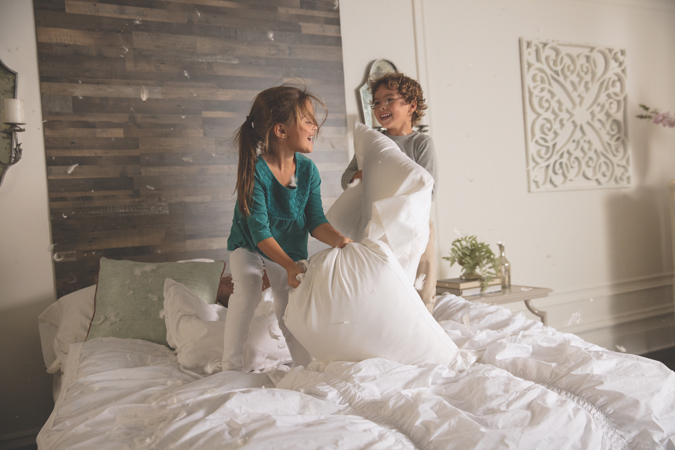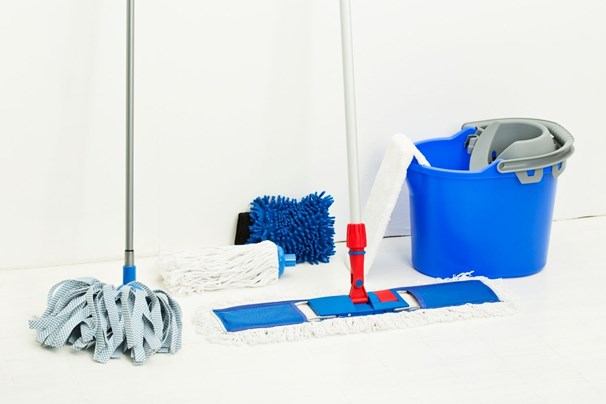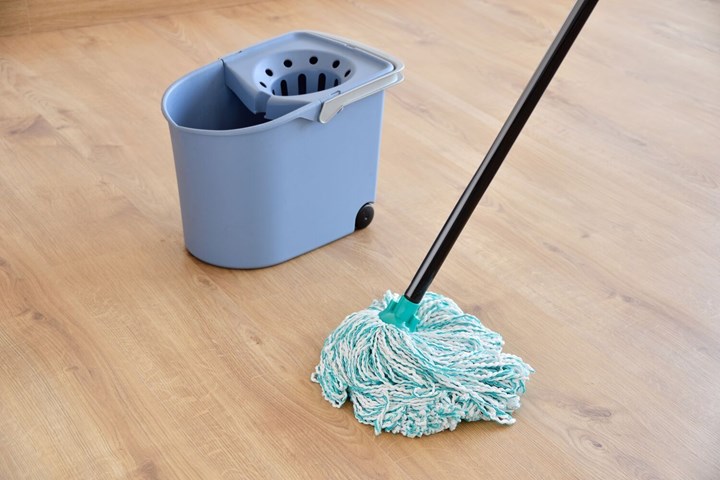Creative Ways to Use Laminate Flooring on Walls
The most popular trend in laminate flooring has nothing to do with your floors. More and more, everyone from DIYers to high-end designers are installing laminate flooring on walls. That’s right—walls.
If you’re suddenly having flashbacks to your grandmother’s laminate wood-paneled walls, hold on a second. A lot has changed in the flooring industry since grandma’s day! For one thing, laminate visuals are more realistic than ever. Mohawk has many laminate designs that hit all the trends and can fit any style—traditional, weathered wood, multi-width planks, high-contrast variations and muted neutrals, just to name a few
Stylistically, there have never been more options in laminate than there are right now. It looks real and even feels real. Go for a vintage look with a textured plank, or opt for the sleek modernism of smooth laminate.
Laminate flooring has come such a long way. It’s easy to install, affordable, strong, durable and easy to clean. These are qualities you want whether the laminate lives on your floor or on your walls. Keep reading for five creative ways you can make a big style statement in your home with a little effort and some Mohawk laminate flooring.
Bedroom Accent Walls
Laminate walls look especially awesome in carpeted rooms like bedrooms and playrooms, where the realistic wood visual really pops. Do you have a contemporary bed frame with a big, empty space above it? Install laminate on the wall behind your bed, adding the design feel of a headboard without the bulk.

The ‘Can I Install Laminate Flooring Over This?’ Guide
We’re listing alphabetically all of the flooring types available so that you can easily determinewhether you can install laminate over that specific flooring type. Remember that laminate flooring
is a floating floor — it will expand and contract as temperature and other conditions change. This means that the choice of subfloor (i.e., what you install laminate over) needs to provide the right support.
Bamboo: Not recommended.
Brick: No. Even with a brick floor in excellent condition, there is the potential for too much surface deviance that could stress the laminate-flooring locking system. And if the floor is below grade, moisture migration will be too difficult to control.
Carpeting, tufted: No. Carpet, its padding, and all its staples must be completely removed — down to the subfloor — before you install laminate flooring.
Carpeting, commercial or needle-bond: No. Some types and styles of commercial or “indoor/outdoor” carpeting may look harmless, but it and any adhesive used to glue it down must be removed before installing a laminate floor.
Carpet tiles: No. Everything has to go. Only the subfloor may remain when you install laminate.
Ceramic tiles: Yes, provided the surface of the floor is flat and level (per our laminate subfloor specifications) and the condition of the floor is good. The tiles themselves must be smooth. You must use padding. Check for cracked or loose tiles and grout — these could be signs of a poor floor condition caused by settling that could cause problems for your laminate floor.
Concrete slab (above grade): Yes. An above-grade concrete floor will most likely be in a commercial building. If that’s the case and you’re not the building owner, you’d better check first. If the building is new construction, the concrete must be completely cured for a minimum of 90 days before installation. We would still recommend a 6-mil vapor barrier and, of course, underlayment padding before installing laminate flooring.
Concrete-slab (below grade): Yes, but be careful. These are usually found in residential basements, and you must be careful about moisture migration from the ground through the concrete. We recommend several ways to test this and steps you can take to control it. And, the concrete must be completely cured a minimum of 90 days. You must use a 6-mil vapor barrier and, of course, underlayment padding. Drains of any kind, French or otherwise, are clear indicators that this concrete floor is not acceptable for laminate installation.
Cork: Yes. But just because it’s a cork floor doesn’t mean you can skip the underlayment. You’ll still need that before installing your laminate floor.
Dirt: No.
Engineered wood: Not recommended under floating floors.
Hardwood: Yes. Keep in mind that in many older homes (40 to 50 or more years old) the planks may be in poor condition, warped, etc. Examine carefully. Inconsistencies in levelness and flatness of the floor surface could create stress points for locking joints and that will cause problems later on.
Laminate: Not recommended under floating floors. Instead, take up all of the old laminate flooring. You may reuse the underlayment for your new floor, provided it’s in good shape.
Linoleum: Yes, provided the surface is flat and level (per our subfloor specifications) and the condition of the floor is good. You must use padding.
LVT Floor (tiles or planks): Yes. The surface must be flat and level (per our subfloor specifications) and the condition of the floor good. You must use padding. Some LVT products are floating systems or “loose-lay” and are easy to remove (preferable). If the floor is glued down, be sure you remove all of the adhesive before installing laminate flooring.
Natural stone (marble, travertine, etc.): It depends. if completely smooth and above ground, then yes; if textured or rough, no.
Outdoor floors, porches, patios or decking of any kind: Never. Laminate flooring is indoor flooring for controlled environments.
OSB floor: Yes. Oriented Strand Board is sometimes used as a subfloor in construction. As with all subfloors, it must meet laminate flooring specifications.
Plywood: Yes. Plywood is most-often used as a subfloor in construction. As with all subfloors, it must meet laminate installation specifications.
Porcelain tile: Yes. The surface of the floor must be flat and level (per our subfloor specifications) and the condition of the floor good. The tiles themselves must be smooth. You must use padding. Check for cracked or loose tiles and grout — these could be signs of a poor floor condition caused by settling which could cause problems for your laminate floor, too.
Saltillo tile: No. Saltillo tile is beautiful, but it’s a bit soft compared to ceramic and porcelain and porous because no glaze is fired onto it. True Saltillo tile also has animal footprints and an uneven surface. You don’t want to install laminate over it.
Sheet-vinyl: Yes, provided the surface is flat and level (per our subfloor specifications) and the condition of the floor is good. You must use padding when installing laminate flooring over sheet vinyl.

the best floor mops for tiles, laminate & wooden floors
There’s nothing like a freshly mopped floor to make you feel happy and result in a clean house, a lovely sense of achievement and pride in your home. Forget dragging around a heavy old floor mop and bucket though. Depending on the type of flooring you have in your home, there’s a bunch of hardworking floor mops on the market with accelerated features that can help you make this happen with less fuss, less effort and even a spring in your step as you get the job done.
What to look for in a mop
When choosing a mop check the manufacturer’s instructions against your flooring type and look for good quality materials and construction. It pays to make a longer-term investment and “Buy once, buy well”. Lighter weight plastic and cheap construction often means the mop will snap or break easily with use and need replacement after a short time, contributing to landfill.
Look for removable and machine-washable pads or mop heads and accessories that mean less waste and a longer lasting product, so more affordable in the long run.
In a similar way to how an iron mists your clothing, spray mops incorporate a water reservoir on the handle and a trigger to dispense water ahead of the mop head as you clean the floor. It works just like wiping a bench with a damp cloth so dries within minutes and does away with the need for a bucket of water.
Spray mops are a great way to control the amount of water you use, particularly on natural timber flooring, which can buckle over time with too much water applied through excessive cleaning.

Things You Must Know Before Hiring A Laminate Flooring Installer
Installing your laminate floor is relatively simple compared to other flooring installations, but still requires skill, hard work, and patience. Your installer should have the specialized knowledge and the proper tools and equipment to complete your job expertly and on time.
Buying your flooring separately and contracting directly with a good installer to put it down for you is a very economical way of getting a great new floor. You can save a lot of money doing it this way, but as always, be careful and take the precaution of getting your agreement in writing.
Independent installers often own small companies. They may work for a number of retailers and contractors. You can generally find them in the Yellow Pages, the ad section of your local paper’s Home section or online. You can also ask friends for referrals. Try to get estimates from at least two installers – three is even better.
Once the installer is in your home, show him the area to be covered and go over this list. Your installer will appreciate this because he, like most people, wants to do the job right and end up with you as another satisfied customer. He will certainly have questions and suggestions of his own.
First of all, he should use a tape measure, a rolling wheel, or a laser measure to determine the size of the flooring area you want to cover. He should deduct the appropriate amount of square footage for any cabinets in the room, and then add 10% (give or take) to the net square footage to cover cutting waste and discarding any boards that may have minor imperfections. He will usually then diagram the area on paper, making a drawing of your rooms with all the dimensions figured in.
Next, show him a sample of the flooring you are considering. This will help him determine what transition strips, stair nosing, floor vents, quarter round, base board and other accessories you will need to purchase.
It’s also important to discuss underlayment with your installer. Decide if you will require a moisture barrier, or heat/cold insulation in addition to sound dampening.
Discuss whether or not it will be necessary to remove the existing flooring before putting down your new one. This may be necessary to achieve a desirable height and condition for meeting a floor in an adjoining room.
He will also check the height of adjoining floors, counter tops, cabinets, etc. to make certain that everything will fit properly after the new floor has been installed. It is essential to have all of your materials at the start of your job in order to get a neatly finished job done on time. We like to say that it is best to start the job right in order to finish it right.
Ask him to confirm that the conditions of your home are suitable for the flooring you want to install. He may ask to remove a piece of existing floor or go into the basement or crawl space to check the condition of the basic floor.
Ask for an itemization of any additional charges for flooring removal, repair of sub-floor, cutting of doors and other work related to the finished product.
If you are living in the home, discuss where the sawing of boards will occur. Specify if you want him to seal off the rooms with plastic and identify who will be responsible for final clean up.
Set aside a “slush fund” in your floor remodeling budget. If removing the existing flooring, your contractor may discover damaged or faulty subflooring that was not visible during the initial inspection and measure. It’s a good idea to have a little extra money set aside for unexpected additional labor costs such as this.
Get the proposal in writing and keep your copy of it in a safe place. It may be a good idea to download a copy of the installation instructions and make that part of your contract. If there is a problem along the way, it is always useful to go back to the written contract. Your contract should include, among other things, the number of square feet you’ll need, and a list of any accessories to buy. It should also include his square foot cost of installation and a total dollar amount for the entire job.

LAMINATE FLOORING – WHAT EXACTLY IS IT?
The look and feel of high-quality laminate floors make them virtually indistinguishable from real wood. Unlike parquet floors, however, they aren’t made from solid wood. Instead, they consist of an engineered wood core layer covered with a decorative layer. Laminate flooring comes in various widths and lengths. Large formats with surrounding V-joint and nature-identical embossing are now especially popular, as they replicate genuine country house-style plank floors more convincingly than ever before. Laminate flooring that is embossed in register – in other words, with the embossing closely following the colours of the grain, a technique that is known in some countries as “synchronized laminate” – looks astonishingly like real wood. Good laminate flooring is also robust, lightfast, easy to clean, and characterised by low emissions.
Laminate Flooring – Flooring with an Eco-Friendly Profile
Laminate flooring is made primarily from wood, in other words from a natural raw material. Despite this, many people still believe that it is plastic. In actual fact, this type of flooring consists of a core of high-density fibreboard (HDF) to which a layer of décor paper is applied. The HDF panels consist to about 90% of wood fibre and 10% of environmentally friendly bonding resin
A Wide Range of Decors for Creatively Pepping Up Your Rooms
A huge range of laminate flooring styles and decors is available for creating an attractive ambience in any room: from classic wood looks, including reinterpretations of eternally popular oak styles, across unusual stone styles, to unicolours and fantasy patterns. Whether you prefer a minimalist atmosphere or trend to a cosier style, whether your favourite décor is oak, beech, maple or nut wood or you get more excited about the look of country house-style planks or a style that’s reminiscent of a ship’s deck, no matter whether you like it sleek and elegant or lively and colourful – with laminate flooring there are practically no limits to what you can do.
Laminate Flooring – Where Can It Be Used?
In private homes, high-quality laminate flooring can be laid just about anywhere. Some varieties are even suitable for kitchens, for which decors that emulate tile or stone are especially popular. Laminate flooring is also often installed in commercial establishments, including hotels, restaurants, offices and shops. These floors naturally take more of a beating than in homes. So make sure that you choose a product of an appropriate utilisation and abrasion resistance class so you can continue enjoying it for a very long time to come.
New Decors – from Idea to Plank
We spoke with our product manager, Achim Scholz, to find out where he gets his inspiration, where new decors come from, and what exactly happens on the way from the idea to the product